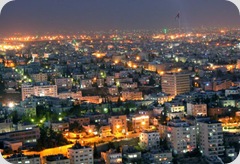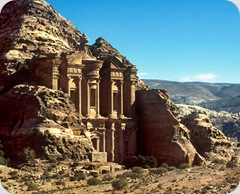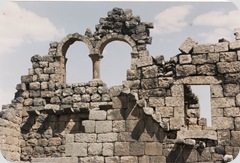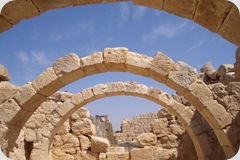Travel to Jordan
Tourism culture and History tour
Jordan travel overview
Bible stories, lost cities, Lawrence of Arabia ... Jordan is associated with many romantic legends. It is a country that should be overflowing with tourists, however, conflicts in the Middle East have kept the masses away. But do not be fooled: Jordan is usually a quiet place. More than that, it's one of the most welcoming and hospitable, and even machismo that prevails so disturbing that there is throughout the region. In what other country could the passenger  leaving their belongings on the street for hours and still be confident that you will find when he returns? In what other country completely unknown people invite tourists to their home, without this meaning that owns a carpet business?
leaving their belongings on the street for hours and still be confident that you will find when he returns? In what other country completely unknown people invite tourists to their home, without this meaning that owns a carpet business?
But Jordan is not just that friendly cup of tea with the natives, is also the scene of two of the most spectacular in the Middle East. Petra, the ancient city of the Nabataeans, flooded with visitors, is one of the most captivating ruins of the World. For a slightly more contemplative experience, do not miss the desert landscape of Wadi Rum, which fascinated Lawrence of Arabia and has pushed more than a typical visitor to the packed Palestinian scarf (kaffiyeh).
best time to visit Jordan
The best time to visit Jordan is in spring or autumn, when they can avoid the summer sun and winter winds. While winter can be terribly cold in much of the country, the Gulf of Aqaba is still enjoyable. If you plan to travel for the rest of the Middle East, one good option is to go north to Turkey in spring, or south toward Egypt in the autumn.
Jordan Festivals and Holidays
Festivals and celebrations are almost all Jordanian Islamic. The biggest one is Ramadan, which lasts one month and in which believers fast from the rising and setting sun. If you travel to Jordan in this period, it is advisable to display sensitive to this fact. Ramadan ends with a great feast, the Eid al-Fitr, where everyone prays together, visits friends, gives presents and enough to eat. The Eid al-adah, held towards the month of February, is the other major festival of the year and marks the time that Muslims should undertake the pilgrimage to Mecca. Among the non-religious celebration is Independence Day on May 25.
Jordan Best Places to travel
Amman
The Jordanian capital with only a few attractions. It is a chaotic mix of traffic and poorly planned urban, but is likely to be moving there sooner or later. Has at least 5000 years old and is full of Roman ruins, including a citadel and a forum. The center is situated at the feet of four of the many hills of the city and is the area of cheap hotels, banks and pockets of attractions. Luxury establishments and embassies are located in the main hill, Jebel Ammán.Puede be a pleasant city, and most of the hospital where travelers can visit.
The reconstructed Roman theater, is east of the city center and the rest is most impressive of the Roman city of Philadelphia. Built in the second century AD, has capacity for 6,000 people and is dug into a hillside that had previously served as a cemetery. This is located at the Odeon, built around the same time and used for musical events. The main source of the city or is nymphaeum West. North of these ruins lies the Roman town, the garrison of the centurions. At present these buildings are little more than rubble, but with the unmistakable features of Roman architecture, Byzantine and Muslim. Here is the National Archeological Museum.
Little affection for the traveler will find the ruins a few exciting things in Amman. You can always try the Folklore Museum and the Museum of traditional costumes and jewelry, located in the Roman theater. North of the city is located to the Unknown Soldier Monument, which includes a museum of military history Jordanian.
The city center of Amman is full of hotels that cost 1.5 dinars from the night. It is also full of shawarma stops, restaurants cheap seats of the Western style fast food and some other Chinese restaurant. It is also the area pubs for tourists. To find fast food restaurant or a Western cosmopolitan Arabic, we should aim at Northeast, a Shmmeisani. For the most luxurious places you should look for in Jebel Amman, west of the city center.
Jerash
50km north of Amman, Jerash is a beautifully preserved Roman city. The area has been inhabited since the Neolithic period and belonged to the Decapolis of Emperor Pompey, a commercial league of ten cities throughout the Middle East. Jerash reached its splendor at the beginning of the third century, but began to decline after 
In Jerash no hotels, but you can get a moderately expensive meal or a snack street. In any case it is a recommended one-day trip from Amman. You can hire a taxi or take a minibus from the terminal to Abdali.
Petra
Throughout Jordan, and perhaps throughout the Middle East is not as impressive as monumental Petra. Was registered in 1985 in the list of World Heritage Sites by Unesco. The prices here are high. Petra was the capital of the Nabataeans, a nomadic Arab people of the second century BC It is a stunning city carved in the wall of a cliff. Forgotten for a thousand years, was not rediscovered until 1812. Until the year 1985 was the refuge of bduls, Bedouin families who have been rehoused in the village of Um Seyhun, a situation which are not entirely satisfied. Do not expect a relaxing visit: Petra receives up to three thousand visitors a day.
To get to capture the atmosphere of this site is advisable to spend a couple of days here. Located in a deep canyon and only accessible through a narrow and winding path (or SIQ) dug into the rock, Petra is carved pink sandstone in acquiring some rust tones combined with dark gray and yellow bands, with 800 monuments carvings. The most famous ruin is the Khazneh, or treasury, whose facade beautifully carved, is the first thing you see when you come from the trail. The monastery is equally imposing, and if it rises to the top views are obtained. Other remains include an amphitheater with a capacity of eight people, and templode the winged lion, which is still digging.
This area is in full swing. Petra and the neighboring village of Wadi Musa many hotels are being built. There are plenty of restaurants, markets and stalls. If not want to stay you can go back to Amman, which is 150 km, but this option is only attractive to visitors with limited time available.
Madaba
Madaba, mentioned in the Bible, is a town 30 km south of Amman, known for its mosaics from the Byzantine period. Most prominent is the map of Madaba, the sixth century, made up of two million pieces, shows the Nile, the Dead Sea and Jerusalem, including the Church of the Holy Sepulcher. This mosaic is in the Greek Orthodox church of St. George. Most of Madaba is now a carefully restored archaeological park, which includes the seventh century church of the Virgin and the prophet Elijah, and the Temple of Hippolytus. The latter hosts a mosaic that shows scenes of the tragedy of Hippolytus and Fedra. In Madaba is a couple of places where to stay, or you can take a bus back to Amman
Umm al-Jimal
Nobody knows for sure who built Umm al-Jimal, a village 10 km from the border with Syria and about 20 km east of al-Mafraq. The strange black basalt settlement is in the south of the city of Haur. Cree was founded in the second century, and at one time formed part of the Roman defensive positions Arabs. Continued to flourish into the Umayyad period, but the earthquakes that hit Jordan in the year 747 Umm al-Jimal razed and the city was never rebuilt. 
Most buildings were reconstructed old homes and businesses of ordinary people. Among the larger buildings that remain standing are a combination of church and barracks and a ruin known as the Western Church. Umm al-Jimal can be visited in a day trip from Amman.
Desert Castles
In the desert east of Amman stands a row of castles, built by the Umayyad dynasty of the seventh century. Some of them were originally Roman buildings, and others from the time of the Nabataeans. The best way is to visit with a rental car or taxi. The main castle can be visited in one day, without leaving too much on the road, but if you were to go through the whole that will provide a couple of days, an all-terrain vehicle and a guide.
Qasr al-Hallabat
 Qasr al-Hallabat was a Roman fort, but taken by the Umayyad palace became a pleasure. A few miles down road is Hammam as-Sarakhs, a spa and hunting. Most of its buildings have been restored almost completely, and you can see the channels that used to bring hot water and steam. A hundred kilometers east of Amman, the oasis town of Azraq has a castle built in black basalt. This was the headquarters of Lawrence of Arabia during the Arab revolt. Back in Amman, the Qusayr'Amra is the best-preserved desert castle, with walls covered with frescoes.
Qasr al-Hallabat was a Roman fort, but taken by the Umayyad palace became a pleasure. A few miles down road is Hammam as-Sarakhs, a spa and hunting. Most of its buildings have been restored almost completely, and you can see the channels that used to bring hot water and steam. A hundred kilometers east of Amman, the oasis town of Azraq has a castle built in black basalt. This was the headquarters of Lawrence of Arabia during the Arab revolt. Back in Amman, the Qusayr'Amra is the best-preserved desert castle, with walls covered with frescoes.
Jordan activities
One of the most successful places to practice diving is the coast of the Gulf of Aqaba (in the far south of Jordan), almost on the Saudi border. This area is full of tropical fish and coral. Aqaba in at least four centers offering diving courses from basic level.
If you want to hike, it is advisable to visit the area around Petra and Wadi Rum. This last practice is also suitable for climbing, and there are establishments in which the leased equipment. Also you can make excursions by camel.
Jordan History
Until the early twentieth century belonged to Jordan Palestinian Territory, most of which is currently the state of Israel. The area is home to one of the oldest towns in the world: the archaeological discoveries of the West Bank of the Jordan River have been dated about 9000 BC Since 3000 a.C. inhabited by the Canaanites and amorritas, and after them the armies of Sargon, king of Sumer and Acad. Abraham led a group of nomads from Mesopotamia and settled in the mountains of Cana (about Israel today). Towards 1023 a.C. The Israelites set up a kingdom, ruled first by Saul and then David took Jerusalem and made it their capital. Rome took Israel in 63 years a.C. and put it under the control of a number of governors, like Pontius Pilate. It is believed that it was at this time that Jesus lived and preached. The irrationality of the growing power of the Empire under Caligula prompted a series of revolts of the Jews, which lasted for years, stopped only when Jerusalem was razed. This defeat marked the end of the Jewish state and the beginning of the Diaspora, the dispersal of most of them.
Early in the fourth century AD, Emperor Constantine converted to Christianity. This aroused a great curiosity to the Holy Land, where many pilgrims came a series of buildings, financed by the wealthiest, like the churches of the Holy Sepulcher and the Nativity of marked religious importance. But the dominance of Christianity in the country would not last long: 638 years in the hands of Jerusalem fell to Caliph Omar and was declared a Holy City of Islam, based on the belief that Prophet Mohammed had ascended to heaven from the top of the mountain of the Temple. Christians reacted against sacrilege and size by the year 1099 gathered an army of Crusaders and occupied Jerusalem, and starting about a hundred years of Christianity. But in 1187 some Muslims to rise up again, and after decades of disputes, the Islamic Mamluks knocked down the last bastion of the Crusaders in 1291.
The following five years were peaceful. Empires rose and fell, and governments changed hands regularly, finally succumbed to the Ottoman Empire. Much of the Jordan desert remained outside of these changes, and remained a Bedouin stronghold. When the Ottomans declined after World War I, Britain took control of Palestine and created the emirate of Transjordan under the rule of King Abdullah.
In 1948 Arab-Israeli war was declared. While everyone was distracted, Transjordan became the West Bank and part of Jerusalem, and was renamed as Jordan. In 1953 King Hussein took the throne and Jordan began to live a period of splendor, an increase of tourism and aid from United States. The Six Day War of 1967 put a stop to the tourism industry in Jordan, when Israel regained the West Bank and half of Jerusalem. In six days Jordan lost its money-making machine and its agricultural land, and found a few thousand Palestinian refugees who fled the Occupied Territories. At the beginning of the 1970s, a faction of the PLO, a refugee in Jordan, threatened the power of King Hussein and an internal war erupted, which ended when the more radical Palestinians marched to Lebanon.
In 1994 Jordan and Israel signed a peace treaty by which they agreed to end the economic barriers and cooperate on security matters and water. That worried Palestinians, who feared being expelled from the region. At the same time, Jordan was strengthening its ties with the Palestinian Authority of Yasir Arafat. Recently it has also restored relations, interrupted during the Gulf War in 1991, with Kuwait and Saudi Arabia. King Hussein began to lead the country toward democracy by Islamic Action Front (with its connections to the Muslim Brotherhood and a somewhat fundamentalist), the most popular so far, but his death in February 1999 has left the future uncertain. The king appointed his eldest son, King Abdullah II, as his successor to the throne weeks before he died, although the constitution stipulates that both parents should be king of Arabs and Muslims by birth (Abdullah's mother was a British citizen who embraced Islam prior to marrying King Hussein) and that the official heir and regent of the king were his brother, Hassan.
King Abdullah has the growing support of the international community and of most Jordanians, including the broad Palestinian community, Palestinian Territory who appreciates the provenance of his wife. Is that going to continue his father's mission: to contribute to stability in the region, achieving a more democratic government, a freer press and equality for women.
The first independent elections in 2003, independent candidate got realistic most of the seats. But he noted that the Jordanian conciliatory foreign policy was under pressure. In October 2002 a U.S. diplomat was assassinated in Amman, the Jordanian embassy in Baghdad was bombed in August 2003, causing 11 deaths. After one month, the central bank changed its decision to freeze the bank accounts of Hamas.
In November 2005, three attacks on luxury hotels, kill 57 people.
Jordan Culture & People
In Jordan there are not too many expressions of traditional Arabic music, but can be found Arabic-style singing with orchestras in Western instruments. Bedoons retain their musical traditions, with groups of men singing songs like trance music, which accompany a single dancer belly dance.
The architecture is visual art that dominates the Arab world, partly because Islam forbids the representation of living forms. Arise throughout the mosques, the remains of the Roman Empire and magnificent mosaics. The Qusayr'Amra is notable for its frescoes, one of which shows a naked woman taking a bath, artistic expression is rare in these regions. The Al-Mu'allaqaat is Arabic poetry before the Koran. One of the most famous works of literature is The Thousand and One Nights (Alf Layla wa Layla), a collection of stories from various countries and eras. Bedouin handicrafts including silver jewelry, brightly colored fabrics and a wide range of knives.
Hospitality is one of the foundations of the Arabic life. For Jordanian families, particularly desert dwellers, is something common to welcome foreigners into their homes. The tradition emerged as a necessity, because of the harshness of life in the desert without food, water and shelter, many passengers had died. It is common to hear the word "welcome", followed by an invitation to visit the home and share with them food and the traditional cup of tea.
Islam, a monotheistic religion whose holy book the Koran, which states on Friday as a day of fasting, is the predominant religion in Jordan. Five times a day believers are called to prayer from the minarets of mosques. Islam derives from the same roots that monotheistic Judaism and Christianity, and Muslims tend to see Christians and Jews, people of the book with respect (Jesus is considered one of the prophets of Allah). Muhammad was the last prophet, and Allah gave him the Koran. The majority of Jordanians, including non-Arab Circassians are Sunni. Circassians (just as other minority Jordanian Chechens) are from the Caucasus area of Russia.
Islamic law forbids eating pork and drink alcohol. Islam tends to separate the sexes, and some restaurants accept only men. These premises, if asked, have a family room, a separate area for women. When Jordanians eat out they will usually order food for the group (a selection of Mezzeh, or appetizers, followed by main dishes to share). Acima Arabic bread or khobz, is eaten with almost everything. The other dishes are basic falafel, chickpeas fried meatballs, the shawarma, slices of grilled lamb, and fuul, a paste of fava beans, garlic and lemon. The mensaf is a specialty of the Bedouin is a whole lamb, head included, served on a bed of rice and pine nuts with yogurt sauce.
Jordan Map





Jordan Select Tours is a travel and tour operator which offers Jordan and Petra tours, holidays at affordable prices. Travel to Jordan with the Jordan incentives, MICE conference organizer and DMC experts.
You don't need magic to disappear. All you need is a destination.